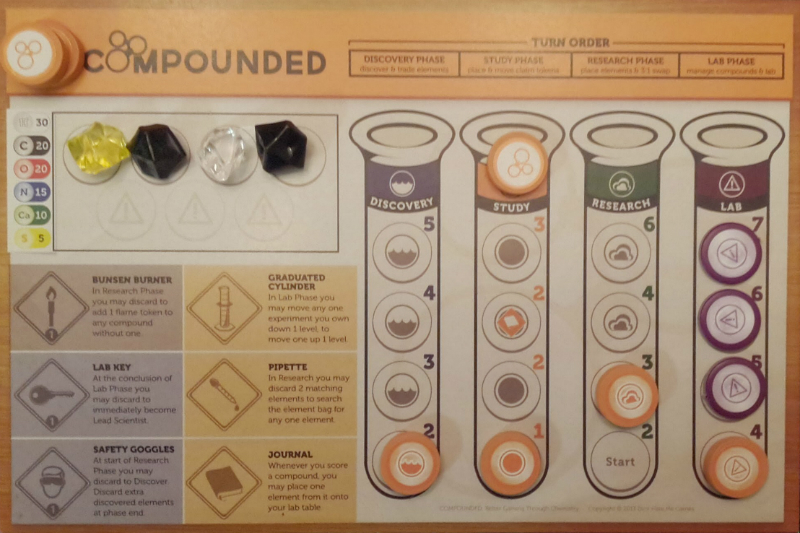If there’s one thing we love more than games at The Cardboard Republic, it’s science.
Well, and dinosaurs. Dinosaurs and science.
So it stands to reason that a board game about science is going to be right up our alley. And when that game also happens to be thoughtfully-designed and well-executed, it’s bound to be a hit. Compounded is all of those things. Really, the only thing it’s missing is the dinosaurs.
The Premise
In Compounded, players wield the elements themselves, all for the glory of science. Science! Here, players are laboratory scientists competing with one another to create a variety of compounds in the most expedient manner possible. Be careful though, because whether it’s by fellow workers coveting each other’s projects – or the occasional explosion – things can get a little unpredictable in the lab.
The Rules
The goal of Compounded is to end the game with the most Atomic Points (AP) by completing compounds, and for a token-laden resource management game, Compound can be set up fairly quickly. Principally, the game is played out on a 4×4 tile grid of different compound cards, with the remaining cards making up the Compound Deck. The Compound Deck will replace those on the board as they are completed or removed. However, to show the inherent danger of rushed science, five Lab Fire cards are also shuffled into the deck that cause, well, fires. Additionally, there’s a series of tokens available that provide various abilities throughout the game when acquired.
Each player receives a Work Bench board which is comprised of four Experiment tracks: Discovery, Study, Research, and Lab. These Experiments also correspond to the four phases of a game round. Players also receive a Fire Extinguisher card, and a Wild Element token that is good for a one-time use as all but the rarest Element in the game, Sulfur.
To begin, players draw four Elements and place them on the spaces in their Work Bench. The player with the rarest Elements goes first.
In the first phase, Discovery, each player draws Elements from the Element bag equal to their Discovery level. Then, players are free to make deals by trading Elements or items with one another. Afterwards, any Elements in excess of a player’s Lab limit are returned to the bag.
Next is the Study phase. Here, players take turns placing Claim tokens on unclaimed compounds, with the total number of Claim tokens a player can have in play equal to their Study level. Doing so guarantees that when the compound is completed, that player is the one to score it. Players are not allowed to remove Claim tokens unless the compound is completed, but a player may opt to move a Claim token from a previous round to a new compound if they wish at the end of the phase.
Third is the Research phase. In order, players place Elements from their Work Bench up to their Research level onto an unfinished Fire Extinguisher or any compounds in play, regardless of whether they are claimed or who claims them. A completed Fire Extinguisher may be used to prevent fires.
Any compound that is completed in Research will be scored in the following phase. If, however, a compound is unclaimed when a player completes it and they have an unallocated Claim token, they may use that Claim token temporarily for scoring purposes.
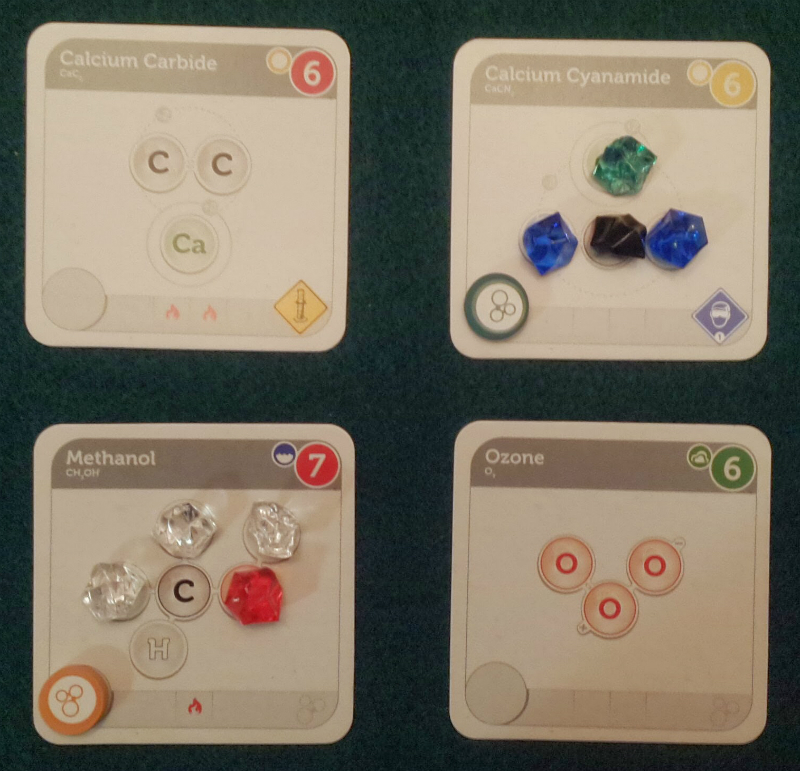
The Green player has completed a compound to be scored. Orange hopes to soon before a Fire occurs.
Once all players have finished placing Elements, the round moves into the Lab phase. Players now score any complete compounds. This consists of gaining the AP amount of the compound, gaining any Lab Tool tokens depicted, and choosing to raise either the Experiment type of the compound or their Lab Experiment level by one.
Lastly, new compounds are revealed to replace completed ones. Be warned, as this can also trigger Lab Fires. Lab Fires cause Flame tokens to be placed on all compounds shown as flammable (unless prevented by a Fire Extinguisher). Should a compound reach its Flame limit, that compound explodes, is removed from the game, and any Elements on that compound are scattered to adjacent compounds.
When a player reaches 50 AP or maxes out three out of four of their Experiment levels, it triggers the last round of the game. Alternatively, if there aren’t enough replacement compounds at the end of the Lab phase, the game ends immediately. The player with the highest AP amount is declared the best lab manager and goes on to a life of cushy grants and exciting research opportunities.
The losers are relegated to years of underappreciated and poorly-paying postdoc work.
Ameri-euros: The Best of Both Worlds
Traditionally speaking, most Resource Management games follow the mold of the classic Euro game. That is, these games emphasize substance over style. Classic Euro games usually have a very loose theme that provides some means of delineating from one another, since many possess nearly-identical mechanics and turn structure. (The pejorative “pushing little blocks of wood around” was not coined by accident.) It’s not that these games aren’t enjoyable, but the audience for these games was on the gameplay itself where they wanted a focus mainly on player-based decisions. The thematic layering added to them was inconsequential at best, and entirely forgettable at worst.
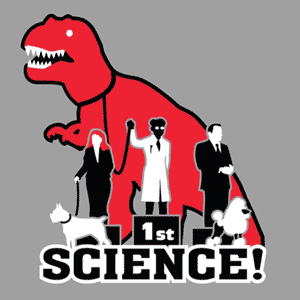
We can have our dinosaurs after all.
That mentality has changed significantly in the last decade or so. What once was a defining factor in the difference between Euros and Ameritrash, thematic elements to all board games have improved substantially. Increasing numbers of designers are putting significant interest into more than just the rules. Not only does this improve the odds of games finding an audience in the growing marketplace, it’s also creating a renewed interest by Immersionists in general to take another look at Euro-style games. With the right blending, they can now have options beyond luck-based games, party games, or pen & paper tabletops.
Compounded is one such example of this. The theme to Compounded is all sorts of nerd-tastic. The point tracker is a Periodic Table. The projects to complete are chemical compositions of known compounds. Flammable compounds can (and do) explode, causing problems for players. The only area of pause is occasional disconnects on why certain compounds are worth what they are given their complexities, but it doesn’t impede the game’s fun. For science-friendly Immersionists – or anyone appreciative of a science themed game – Compounded delivers an enjoyable and fantastically poignant atmosphere of playing around with chemistry.
Granted, this flavor-added part of the game doesn’t actually require you to be well versed in a hard science field (possibly to the dismay of some hoping for more), but Compounded doesn’t pretend to offer more substance than it does. If the chemistry-tinted veneer were removed, the result would indeed be another fairly lightweight resource management game, akin to those more classic Euros. However, Compounded is a great example of a game that catches a wider net simply by having a broader thematic appeal than merely little wooden blocks, and its theme should certainly be a mark in its favor rather than a strike against it.
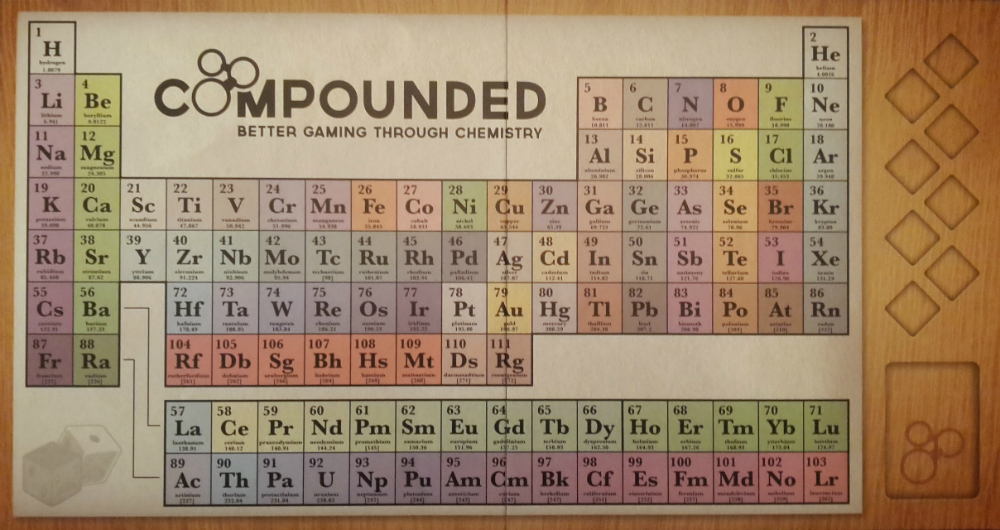
This is the score track. And yes, we know what you’re thinking: we couldn’t figure out why it stops at 111 either. At the very least we should see Copernicium (112) since it was named in 2010 by the IUPAC, right? You know what we mean.
A Solid Mixture
Regardless of the visuals, the Compounded is still substantively a game about controlling your resources and using them wisely to gain points and more potent Experiments. Unsurprisingly, the game’s appeal falls largely along the standard Euro game lines of interest.
For Tacticians, this is easily a game in their corner. It’s ultimately about controlling the items you have and leveraging them for more down the road. Compounded even has a tech tree of sorts – deciding which Experiments to raise means working towards completing compounds of that type. The game would be less appealing to them if the only way to get Elements is through the Discovery draw, but by including things like bartering with other players and a costly-but-available exchange rate, you have options for thinking further ahead than merely what you have in front of you.
At the opposite end of the spectrum, Daredevils generally don’t find games based solely around resource management overly enticing as they’re designed around making deliberate strategic decisions that make sense. The same is true with Compounded. Aside from trying to intentionally cause fires just to mess with other players, there’s not much out of the box maneuvering to take. (Plus it’s not all that easy to do.)
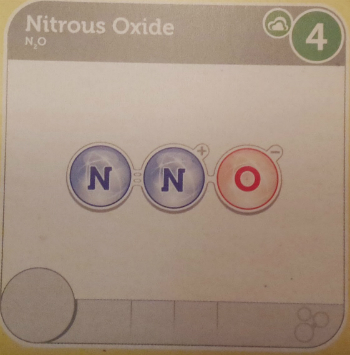
See? Science can be a laughing matter.
Interestingly, Architects normally tend to feel the same about resource games as Daredevils, but they differ here. Compounded does more than simply make a player trade Element A for Element B, and then Element B for Atomic Points. Completing the compounds is how you score points, yes, but at the same time there’s a sense of progression and growth as your Experiments progress. They’ll enjoy that. Moreover, they appreciate that you can trigger the endgame by advancing those Experiment tracks instead of only having the option of reaching 50 AP first.
Similarly, it’s no surprise Socializers don’t find enjoyment in highly complex games, but as resource management games go, Compounded is certainly on the lighter end of them. The rules can be explained pretty quickly, the rounds go by at an honest pace, and the end game seems to trigger at just the right time to keep the game from starting to drag on or feel repetitive. Still, it’s likely just a tad more complex for pure Socializers tastes, unless they have a really good attention span.
Pure Strikers will also have a difficult time with Compounded. There’s not a ton of player interference that goes on here, with each player individually advancing their own agenda. You can still play assertively, for example, by deliberately Claiming projects so another player can’t, but such moves are often at the cost of the time needed to advance your own goals. Conflict is present in the game, but the game has an air of professional rivals rather than actual enemies. In some cases, and in some variants, cooperation is even necessary for players to move forward. Sorry Strikers, but there’s no advocacy of cutthroat science here. (Which, if movies and books have taught us anything, is probably a good thing…)
The Takeaway
Compounded is a decent example of how the gaming industry continues to evolve. It feels much like a Gateway Game for Euros. On the one hand, it illustrates how thematic elements play an important role in retaining someone’s attention if they aren’t a mechanics-centric player. On the other hand, it doesn’t rely solely on flavor or luck alone. With a number of different variants that alter the flow of the game and a concise but easy to understand strategy, Compounded lets players make worthwhile decisions each time it’s brought to the table. The end result is a game that appeals to fans of lightweight resource management, families looking for a new game night addition, or even a game to potentially assist in educating students about science in a fun way. It focuses less on deeply complex moves and more on showing that Euros can be thematically rich with widespread appeal. (Especially if that focus is on something as awesome as science.) And in that, it appears that Compound’s formula was completed successfully and is ready for consumption.
Compounded is a product of Dice Hate Me Games.
Cardboard Republic Snapshot Scoring (Based on scale of 5):
Artwork: 4
Rules Clarity: 4.5
Replay Value: 4.5
Physical Quality: 4
Overall Score: 4
Photo Credits: Best in Show Dinosaur by Wear Science.

